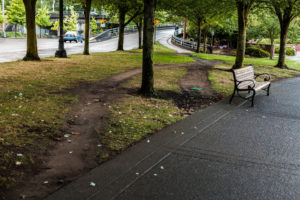You must follow exactly the path that the Lord your God has commanded you.
Deuteronomy 5: 33
One of my favourite moments is discovering that a term exists for something that I encounter on a regular basis but that has always defied labels. ‘Agraffes’ and ‘Aglets’ are two words that delighted me and that have stayed in my vocabulary since I first discovered them. The first is the wire cage around a champagne cork; the second is the little plastic tip on a shoelace. When a publican friend of mine referred to the foam on the top of my badly drawn beer as ‘barm’ I was equally pleased. Less useful was the discovery that the space between our eyebrows is known as the ‘glabella’ or that the space between the nose and upper lip is the ‘philtrum’. Who knew?
As a builder in my earlier years, I similarly delighted in the names applied to everyday architecture. I loved the poetry of referring to steps that are narrower on one side than the other as ‘winders’ and was over the moon when I learned that when three or more of these steps turn the corner they become ‘kite winders’ (have a look at their shape). Or what about the small oval windows that we see in older buildings? The ‘bull’s eye’ or ‘oculus’ is a marvel of simplicity and style.
This discovery of names can be repeated across everything in our world, from spaces on our bodies to the effect of weather on our moods. So, I was not surprised to learn that those shortcut pathways we so often find in public spaces that deviate from the formal sidewalks, and that cut across the grass, also have a name: ‘desire paths.’ We are all familiar with these anarchic throughways that refuse the well-paved but often longer sidewalks to cut through a field to get more quickly to a destination. Our campus is certainly filled with these. I recall once approving the paving of a space that had been carved out by students over many years, only to find that a new, even more radically abbreviated and unofficial pathway appeared some months later. The heart — and the feet — wants what it wants.

Desire Paths. Photo by Duncan Rawlinson
Much has been written about these desire paths. The famed spatial critic Jane Jacobs once noted that ‘There is no logic that can be superimposed on the city; people make it and it is to them … that we must fit our plans’. Critics have argued that desire paths are both practical in that they find the shortest distance (or route) between two destinations; but they are also reflective of our desire to resist boundaries — a perhaps benign type of civil disobedience. Some institutions, like Michigan State University for example, waited until the general populace had spoken with their feet before putting down official pathways.
What is true of spatial geography is surely true of our spiritual architecture. As a child I was taught that there was one truth, that it was wrong to question and that I had to accept blithely all that I was told. It meant, of course, that I felt I couldn’t question contradictions, I couldn’t truly deepen my understanding of complex matters, and I was pushed, it seemed, either to acquiesce or rebel. It wasn’t until much later in life, in conversation with close friends who were priests and nuns, that I understood that blind acceptance isn’t deep faith. Faith is having the courage and the curiosity to ask difficult questions. Faith is about discovery and analysis, a hallmark of the mission of Christian universities, for example, where faith and reason are conjoined — connected — in healthy dialogue.
The geography of our faith life is a complex one, overwritten by many narratives, edited and abridged at times, elaborated and expanded at others. The ethical and moral paths we follow wind through neighbourhoods of great complexity and contradiction, with many detours along the way. For many of us, we follow our hearts on a journey that is only partially understood, though hopefully with a strong moral compass as our guide. In the end, human beings must balance their journey between following set walkways and pursuing desire paths. These different paths may lead to the same place, though the experience and richness of the journey may be significantly different.
Our faith provides a blueprint for our journey. Our sacred texts are the guidebook that we need to stay connected. We have a responsibility to interpret and assess, question and marvel, so that we chart a path that is noble and good, so that the journey is as worthy as the final destination. That should be our heart’s desire.








Enjoyed this article so much – had to look up the word publican! Love what was said “In the end, human beings must balance their journey between following set walkways and pursuing desire paths” … pretty sure “Desire Path” will be the title of a future painting.